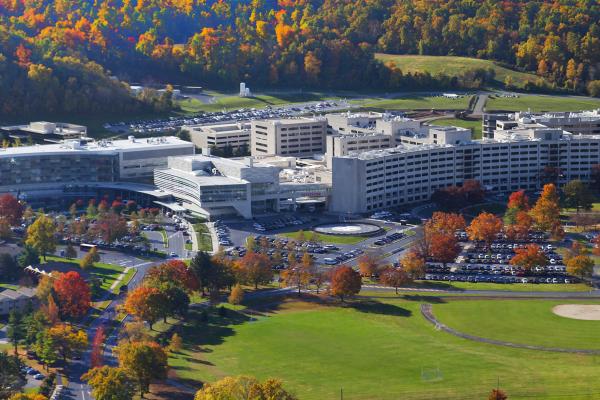A tumor that occurs in the bones and soft tissues
A sarcoma is a cancerous tumor that can grow in any part of the body. Soft tissue sarcoma (STS) is rare, yet there are more than 50 different types. The more frequent types include:
- Dermatofibrosarcoma/DFSP (skin)
- Fibrosarcoma (connective tissue)
- Hemangioendothelioma (blood vessels)
- Kaposi's sarcoma (skin and mucous membranes)
- Liposarcoma (fat)
- Leiomyosarcoma (smooth muscles of internal organs)
- Lymphangiosarcoma (lymph vessels)
- Peripheral nerve sheath tumor (nerves)
- Pleomorphic sarcoma (any soft tissue)
- Rhabdomyosarcoma (skeletal muscles)
- Synovial sarcoma (arm and leg joints)
Soft tissue sarcomas most often occur in the arms and legs. The tumors vary from patient to patient, but usually appear as a small painless lump.
Scientists still don't know exactly what causes most soft tissue sarcomas. Research is ongoing, as doctors work to improve diagnosis and treatments. Right now, the most common treatment is surgery to remove the tumor. Sometimes radiation or chemotherapy will follow.
Q&A. We’re sharing insights about Sarcoma with Dr. Colette Pameijer, a surgical oncologist at Penn State Health Milton S. Hershey Medical Center. It's often considered "the forgotten cancer." Sarcoma is a tumor that occurs in the bones and soft tissues such as fat and muscle. There's a lot we don't know about sarcoma, including the cause. We'll learn about the symptoms of sarcoma, how it's treated and more.
Treatment
Sarcomas are rare tumors, and it takes an experienced multidisciplinary team to correctly diagnose and manage them. All the Penn State Cancer Institute specialists involved in your care work together to create a treatment plan that suits the patient. They consider the size of the tumor, its location, how advanced it is and how healthy you are.
Surgery
Doctors typically treat soft tissue sarcoma with surgery.
- In the early stages, the tumor and some healthy tissue around it is removed.
- In more advanced stages, surgery may be followed by radiation or chemotherapy.
- If the cancer is found at a late stage in an arm or leg, the limb may need to be amputated (removed). That is very rare.
Chemotherapy
Chemotherapy may be used to help kill cancer cells that have spread to different areas of the body. A new approach infuses the chemotherapy only where the cancer is found.
Radiation Therapy
Radiation or chemotherapy may be used:
- Before surgery to help shrink the tumor to make it easier to remove.
- After surgery to kill any remaining cancer cells.
Symptoms and Diagnosis
A sarcoma is a rare kind of cancer. Sarcomas are different from the much more common carcinomas because they happen in a different kind of tissue.
Symptoms
See your doctor about any lump, even if it is not painful. Most lumps are not cancer, but must be checked to make sure.
In the early stages of soft tissue sarcoma, there are often no symptoms. As the tumor grows, it may cause a lump or swelling that keeps growing over time.
Sometimes these symptoms appear:
- Pain, if the tumor presses on a nerve, organ, blood vessel or muscle
- Blockage or bleeding in the stomach or intestines
- Breathing problems
Diagnosis
If your doctors suspects sarcoma, he or she will take your medical history and give you a physical exam. You may undergo medical tests, such as:
- X-ray
- CT scan
- MRI
- PET scan
Biopsy
If your doctor suspects cancer, you might have a biopsy. A tissue sample will be taken from the tumor and examined by a pathologist. The biopsy will show if cancer is present and help show how quickly it is growing.
Staging
Your medical team needs to know what stage your cancer is in: the early, middle or advanced stage. Your team may ask for staging tests to tell how much cancer is present and if it has spread.
Outlook & Prognosis
When soft tissue sarcoma is found and treated in its early stage, the outlook for the patient is very good. Most people who survive five years can expect to be cancer-free 10 years later. Studies show that:
- If the cancer has not spread, more than eight out of every 10 people treated for sarcoma remain cancer-free after five years.
- If the cancer has only spread near to the tumor (locally), more than half of the people treated are still cancer-free five years later.
- If the cancer has spread to distant body parts, 16 percent of people treated remain cancer-free at five years.
Meet the Team
Support Groups
Support groups provide an opportunity to share your feelings and connect with other patients and caregivers who are experiencing similar struggles.
Convenient Locations
Find the care your family needs, close to home, at one of our many locations throughout central Pennsylvania.
Find a location near you


